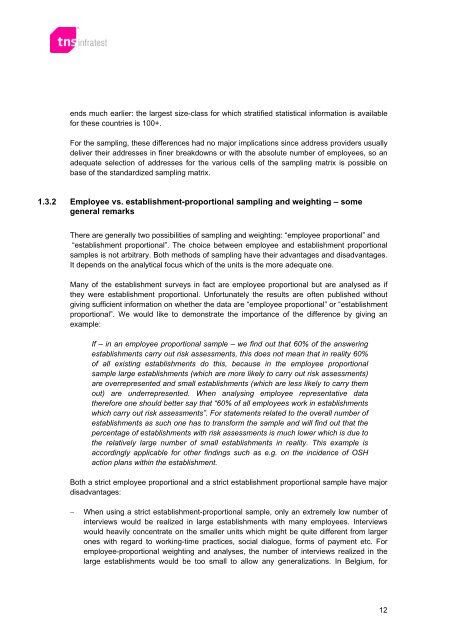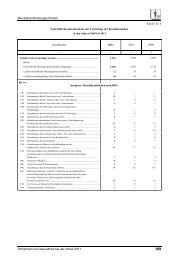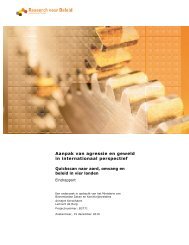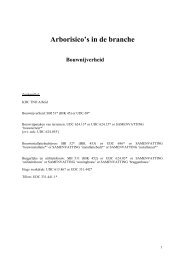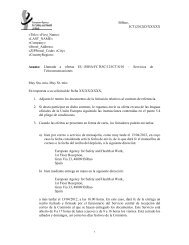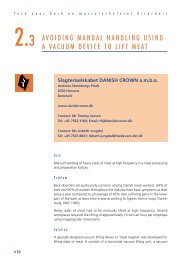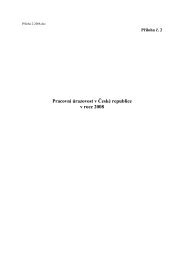ESENER-PSR 2009 - European Agency for Safety and Health at Work
ESENER-PSR 2009 - European Agency for Safety and Health at Work
ESENER-PSR 2009 - European Agency for Safety and Health at Work
Create successful ePaper yourself
Turn your PDF publications into a flip-book with our unique Google optimized e-Paper software.
ends much earlier: the largest size-class <strong>for</strong> which str<strong>at</strong>ified st<strong>at</strong>istical in<strong>for</strong>m<strong>at</strong>ion is available<br />
<strong>for</strong> these countries is 100+.<br />
For the sampling, these differences had no major implic<strong>at</strong>ions since address providers usually<br />
deliver their addresses in finer breakdowns or with the absolute number of employees, so an<br />
adequ<strong>at</strong>e selection of addresses <strong>for</strong> the various cells of the sampling m<strong>at</strong>rix is possible on<br />
base of the st<strong>and</strong>ardized sampling m<strong>at</strong>rix.<br />
1.3.2 Employee vs. establishment-proportional sampling <strong>and</strong> weighting – some<br />
general remarks<br />
There are generally two possibilities of sampling <strong>and</strong> weighting: “employee proportional” <strong>and</strong><br />
“establishment proportional”. The choice between employee <strong>and</strong> establishment proportional<br />
samples is not arbitrary. Both methods of sampling have their advantages <strong>and</strong> disadvantages.<br />
It depends on the analytical focus which of the units is the more adequ<strong>at</strong>e one.<br />
Many of the establishment surveys in fact are employee proportional but are analysed as if<br />
they were establishment proportional. Un<strong>for</strong>tun<strong>at</strong>ely the results are often published without<br />
giving sufficient in<strong>for</strong>m<strong>at</strong>ion on whether the d<strong>at</strong>a are “employee proportional” or “establishment<br />
proportional”. We would like to demonstr<strong>at</strong>e the importance of the difference by giving an<br />
example:<br />
If – in an employee proportional sample – we find out th<strong>at</strong> 60% of the answering<br />
establishments carry out risk assessments, this does not mean th<strong>at</strong> in reality 60%<br />
of all existing establishments do this, because in the employee proportional<br />
sample large establishments (which are more likely to carry out risk assessments)<br />
are overrepresented <strong>and</strong> small establishments (which are less likely to carry them<br />
out) are underrepresented. When analysing employee represent<strong>at</strong>ive d<strong>at</strong>a<br />
there<strong>for</strong>e one should better say th<strong>at</strong> “60% of all employees work in establishments<br />
which carry out risk assessments”. For st<strong>at</strong>ements rel<strong>at</strong>ed to the overall number of<br />
establishments as such one has to trans<strong>for</strong>m the sample <strong>and</strong> will find out th<strong>at</strong> the<br />
percentage of establishments with risk assessments is much lower which is due to<br />
the rel<strong>at</strong>ively large number of small establishments in reality. This example is<br />
accordingly applicable <strong>for</strong> other findings such as e.g. on the incidence of OSH<br />
action plans within the establishment.<br />
Both a strict employee proportional <strong>and</strong> a strict establishment proportional sample have major<br />
disadvantages:<br />
When using a strict establishment-proportional sample, only an extremely low number of<br />
interviews would be realized in large establishments with many employees. Interviews<br />
would heavily concentr<strong>at</strong>e on the smaller units which might be quite different from larger<br />
ones with regard to working-time practices, social dialogue, <strong>for</strong>ms of payment etc. For<br />
employee-proportional weighting <strong>and</strong> analyses, the number of interviews realized in the<br />
large establishments would be too small to allow any generaliz<strong>at</strong>ions. In Belgium, <strong>for</strong><br />
12


